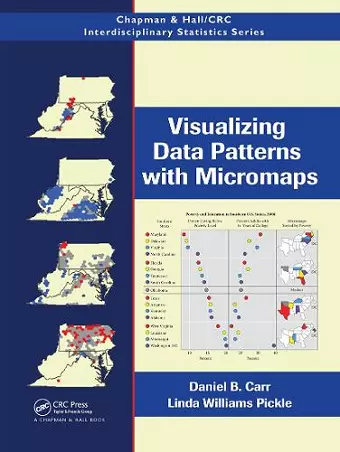Visualizing Data Patterns with Micromaps
Daniel B Carr author Linda Williams Pickle author
Format:Paperback
Publisher:Taylor & Francis Ltd
Published:21st Jan '23
Currently unavailable, and unfortunately no date known when it will be back
This paperback is available in another edition too:
- Hardback£82.99(9781420075731)

After more than 15 years of development drawing on research in cognitive psychology, statistical graphics, computer science, and cartography, micromap designs are becoming part of mainstream statistical visualizations. Bringing together the research of two leaders in this field, Visualizing Data Patterns with Micromaps presents the many design variations and applications of micromaps, which link statistical information to an organized set of small maps. This full-color book helps readers simultaneously explore the statistical and geographic patterns in their data.
After illustrating the three main types of micromaps, the authors summarize the research behind the design of visualization tools that support exploration and communication of spatial data patterns. They then explain how these research findings can be applied to micromap designs in general and detail the specifics involved with linked, conditioned, and comparative micromap designs. To compare and contrast their purposes, limitations, and strengths, the final chapter applies all three of these techniques to the same demographic data for Louisiana before and after Hurricanes Katrina and Rita.
Supplementary websiteOffering numerous ancillary features, the book’s website at http://mason.gmu.edu/~dcarr/Micromaps/ provides many boundary files and real data sets that address topics, such species biodiversity and alcoholism. One complete folder of data examples presents cancer statistics, risk factors, and demographic data. The site includes CCmaps, the dynamic implementation of conditioned micromaps written in Java, as well as a link to a generalized micromaps program. It also contains R functions and scripts for linked and comparative micromaps, enabling re-creation of all the corresponding examples in the book.
This is an interesting book written by two experts in the field with more than 15 years of productive research in the area of micromaps. … The authors have created examples using R functions and scripts provided on a Web site. In the last chapter the authors apply the three types of micromap to demographic data for Louisiana state. It is a very practical way of finishing this fascinating book. I strongly recommend this book to anyone who is interested in data visualization techniques. Micromaps are applicable to data from a wide range of disciplines. …
—M. Dolores Ugarte, Journal of the Royal Statistical Society, Series A, 2012
The book is well-written and nicely organized … Overall, I found the book is well-researched and informative. It uses lucid and easy-to-understand language. Additionally, the book contains numerous colorful micromap variations that visually illustrate design principles and real-world applications. It clearly shows the authors’ enthusiasm for micromaps and their deep knowledge of the subject. … I highly recommend this book for a diverse audience who are interested in exploring and presenting their data in a joint statistical and spatial context. … an excellent text for graduate courses in data visualization. The authors clearly succeeded in making this book suitable for teaching by providing both theoretical foundations and practical examples for designing effective visualization tools. An attractive feature of the book is that it has a companion website … I congratulate the authors for this great book. It will be an excellent addition to the data visualization literature and I will definitely use it as my reference.
—Samson Y. Gebreab, The American Statistician, August 2011
[M]icromaps are an effective tool and the book explains them at length, with lots of examples, so that non-statisticians can understand and use them. … the graphic displays in this book are clear and straightforward …
—International Statistical Review, 2011
The book is extremely well written. I was totally absorbed by chapters one through four. It is obvious that the authors are in total command of the topic and bring years of experience in the field to the project. The authors understand what areas need special attention and explanation. The language flows nicely and the text is illustrative and entertaining. The limitations of micromaps are known and discussed. The reader gains a good understanding of what they are for and what they can and cannot accomplish.
—Oliver Schabenberger, SAS Institute Inc., Cary, North Carolina, USA
This is a terrific book and it introduces some clever tools.
—David Berrigan, NIH/NCI
ISBN: 9781032477671
Dimensions: unknown
Weight: 526g
182 pages